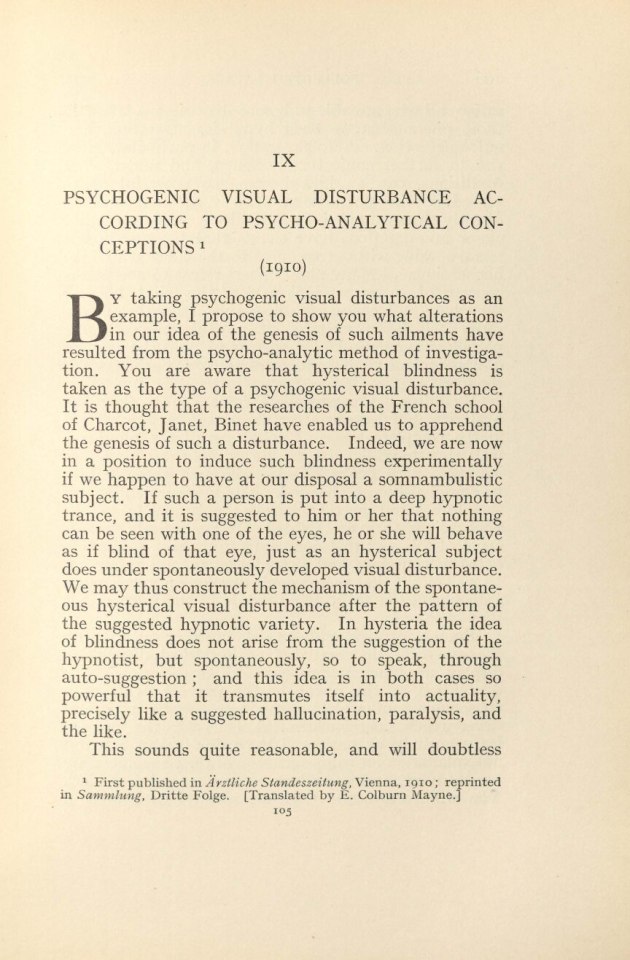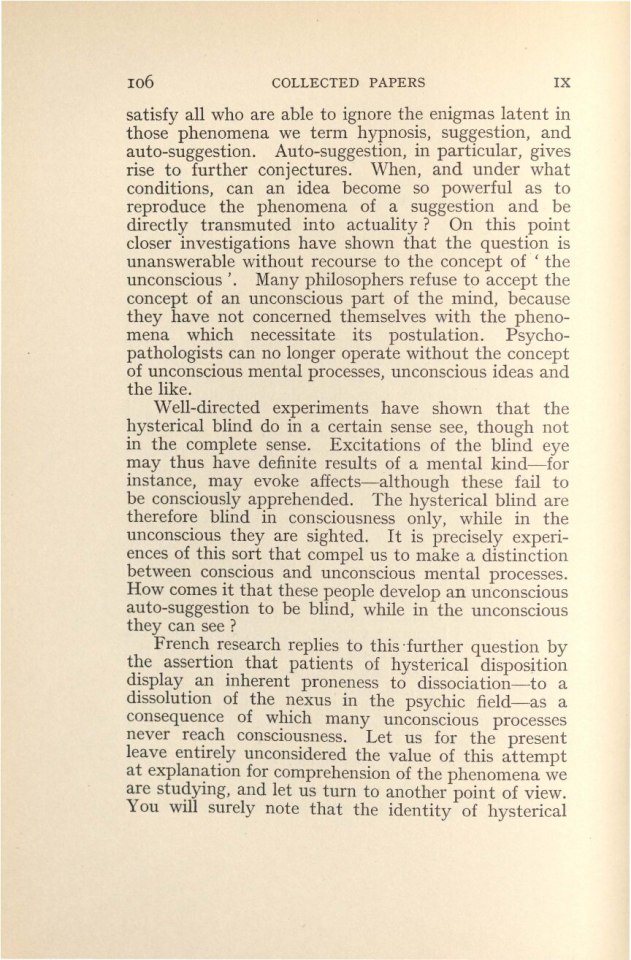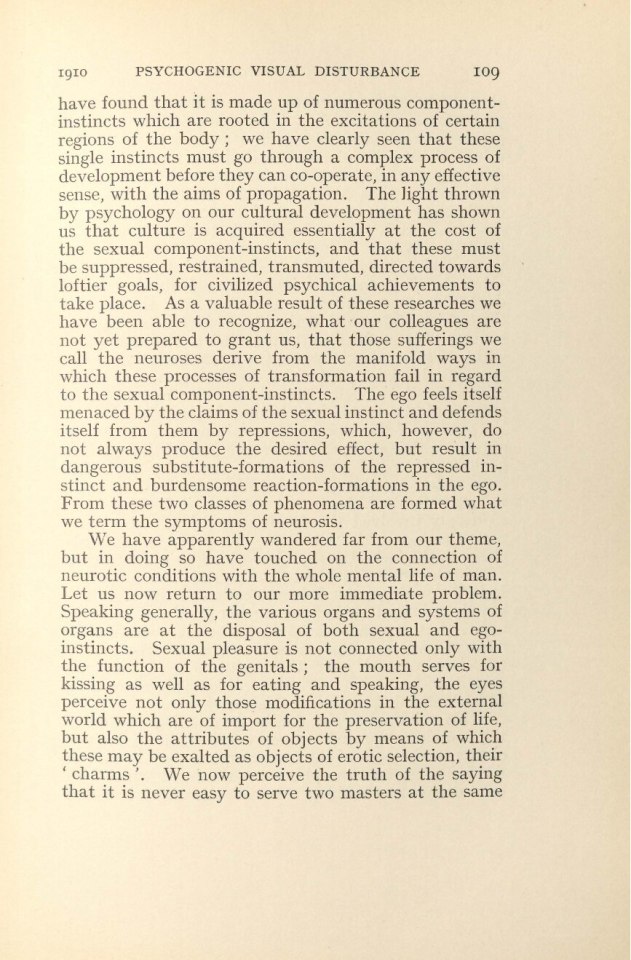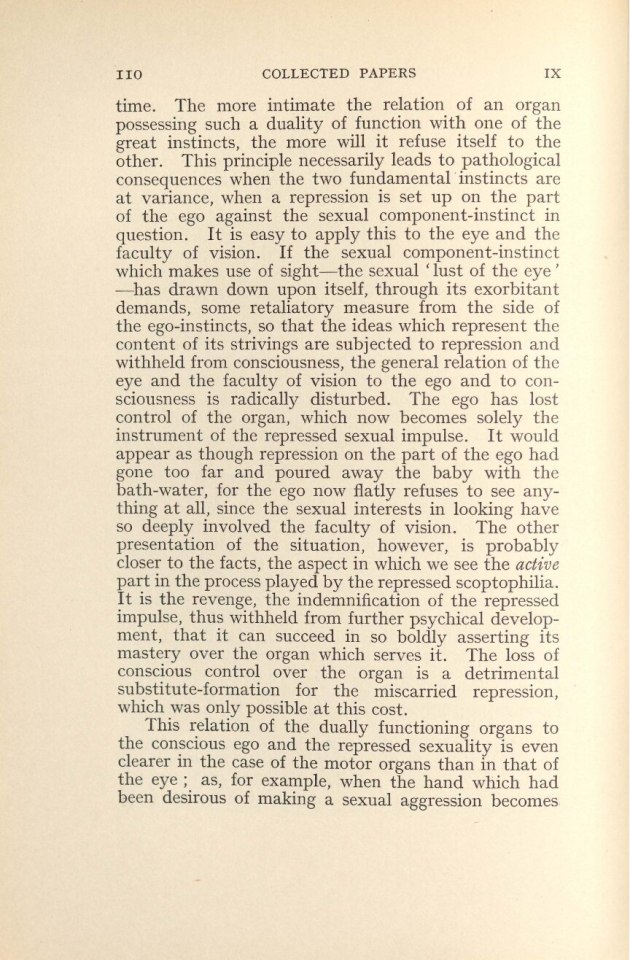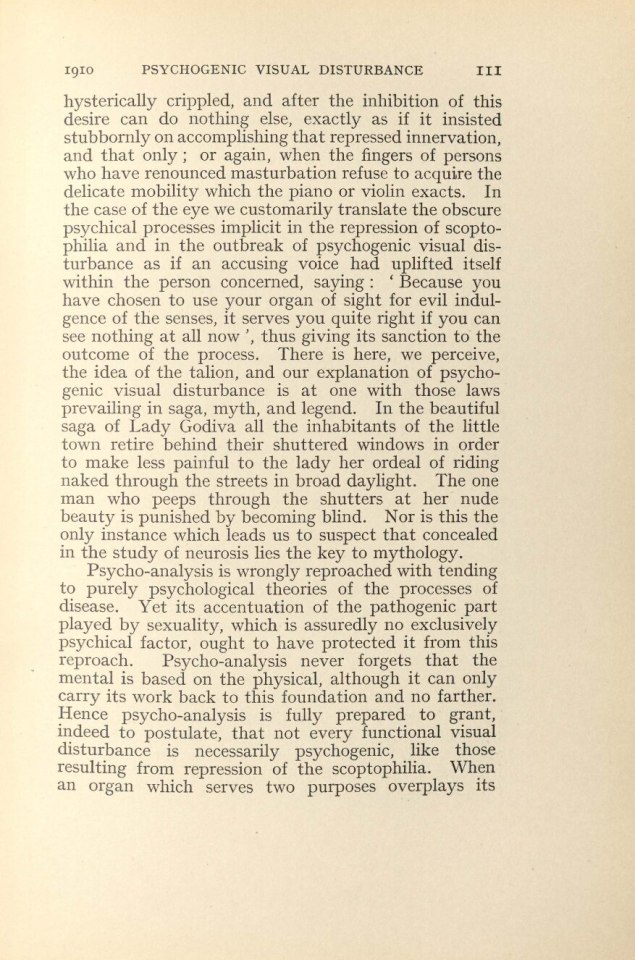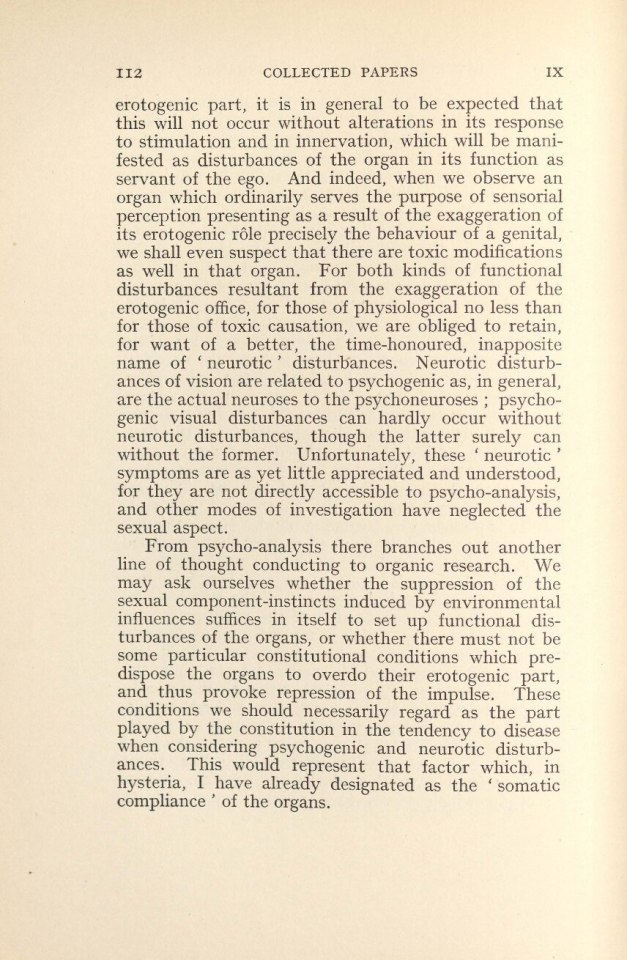S.
PSYCHOGENIC VISUAL DISTURBANCE AC-
CORDING TO PSYCHO-ANALYTICAL CON-CEPTIONS ı
(1910)Y taking psychogenic visual disturbances as an
B:*; I propose to show you what alterations
in our idea of the genesis of such ailments have
resulted from the psycho-analytic method of investiga-
tion. You are aware that hysterical blindness is
taken as the type of a psychogenic visual disturbance.
It is thought that the researches of the French school
of Charcot, Janet, Binet have enabled us to apprehend
the genesis of such a disturbance. Indeed, we are now
in a position to induce such blindness experimentally
if we happen to have at our disposal a somnambulistic
subject. If such a person is put into a deep hypnotic
trance, and it is suggested to him or her that nothing
can be seen with one of the eyes, he or she will behave
as if blind of that eye, just as an hysterical subject
does under spontaneously developed visual disturbance.
We may thus construct the mechanism of the spontane-
ous hysterical visual disturbance after the pattern of
the suggested hypnotic variety. In hysteria the idea
of blindness does not arise from the suggestion of the
hypnotist, but spontaneously, so to speak, through
auto-suggestion ; and this idea is in both cases so
powerful that it transmutes itself into actuality,
precisely like a suggested hallucination, paralysis, and
the like.
This sounds quite reasonable, and will doubtlessFirst published in Ärztliche Standeszeitung, Vienna, 1910; reprinted
in Sammlung, Dritte Folge. [Translated by E. Colburn Mayne.
105S.
106 COLLECTED PAPERS 1X
satisfy all who are able to ignore the enigmas latent in
those phenomena we term hypnosis, suggestion, and
auto-suggestion. Auto-suggestion, in particular, gives
rise to further conjectures. When, and under what
conditions, can an idea become so powerful as to
reproduce the phenomena of a suggestion and be
directly transmuted into actuality? On this point
closer investigations have shown that the question is
unanswerable without recourse to the concept of ‘the
unconscious ’. Many philosophers refuse to accept the
concept of an unconscious part of the mind, because
they have not concerned themselves with the pheno-
mena which necessitate its postulation. Psycho-
pathologists can no longer operate without the concept
of unconscious mental processes, unconscious ideas and
the like.Well-directed experiments have shown that the
hysterical blind do in a certain sense see, though not
in the complete sense. Excitations of the blind eye
may thus have definite results of a mental kind—for
instance, may evoke affects—although these fail to
be consciously apprehended. The hysterical blind are
therefore blind in consciousness only, while in the
unconscious they are sighted. It is precisely experi-
ences of this sort that compel us to make a distinction
between conscious and unconscious mental processes.
How comes it that these people develop an unconscious
auto-suggestion to be blind, while in the unconscious
they can see ?French research replies to this-further question by
the assertion that patients of hysterical disposition
display an inherent proneness to dissociation—to a
dissolution of the nexus in the psychic fieldl—as a
consequence of which many unconscious processes
never reach consciousness. Let us for the present
leave entirely unconsidered the value of this attempt
at explanation for comprehension of the phenomena we
are studying, and let us turn to another point of view.
You will surely note that the identity of hystericalS.
1910 PSYCHOGENIC VISUAL DISTURBANCE 107
blindness with that produced by auto-suggestion, which
I emphasized in my opening words, is here abandoned.
Hysterical patients are not blind as a result of the
auto-suggestive idea that they cannot see, but as a
result of a dissociation between unconscious and
conscious processes in the visual act; their idea that
they cannot see is the logical expression of a mental
condition, and not the causation of it.If you demur to the foregoing delineation on the
ground of obscurity, I shall not find it easy to defend
myself. I have attempted to give you a synthesis of
the views of different investigators, and in doing so
have probably drawn the links too closely together.
My desire was to condense into a homogeneous whole
the prevailing contributions towards an understanding
of psychogenic disturbances—their origin in over-
mastering ideas, the distinetion between conscious and
unconscious mental processes, and the hypothesis of
psychic dissociation—and in this I was able to succeed
no better than the French writers, with Pierre Janet
at their head. Pardon me therefore not only the
obscurity but also the inaccuracy of my delineation, and
let me tell you how psycho-analysis has led us to a
more firmly based and probably a more authentic view
of psychogenie visual disturbances.Psycho-analysis, too, accepts the hypothesis of
dissociation and of the unconscious, but sets them in
a different relation to each other. Psycho-analysis is
a dynamic conception, which reduces mental life to
the interplay of reciprocally urging and checking
forces. When it happens that a group of ideas remains
in the unconscious, psycho-analysis sees in this no
proof of a constitutional incapacity for synthesis,
exhibiting itself through this particular dissociation,
but maintains that an active antagonism of certain
groups of ideas has caused the isolation of another
group in the unconscious. The process which imposes
such a fate upon a given group is termed by psycho-
analysis “repression ’, and it recognizes in it some-S.
108 COLLECTED PAPERS IX
thing analogous to reasoned rejection in the sphere
of logic. Psycho-analysis can show that such repres-
sions play an extraordinary part in our mental life,
that they may frequently miscarry in individual cases,
and that such miscarriages of repression are the
primary cause of symptom-formation.If, then, psychogenic visual disturbance, as we have
learnt, is based on the segregation from consciousness
of certain ideas connected with seeing, the psycho-
analytical mode of thought constrains us to assume
that these ideas have come into opposition with other
more powerful ideas (which we should ascribe to our
conception of the ego, which has had a varying sig-
nificance) and have therefore become repressed. But
where can any such opposition, calling for such re-
pression, arise between the ego and single groups of
ideas? You will observe that this question could not
have been posed before the advent of psycho-analysis,
for before that nothing was known about mental
conflict and repression. Our researches have now put
us in a position to give the required answer. Our
attention has been drawn to the significance of the
instincts in the conceptual life; we have learnt that
every instinct seeks to come to expression by activating
those ideas which are in accordance with its aims.
These instincts do not always agree with one another,
and this frequently results in a conflict of interests ;
the contradictions in the ideas are merely the expression
of the battle between the various instincts. Of quite
peculiar significance for our efforts towards elucidation
is the undeniable opposition between the instincts
which serve the purposes of sexuality, of gaining
sexual pleasure, and those others which aim at the
self-preservation of the individual, the ego-instincts.
Schiller said that we can classify under ‘hunger ’
or under ‘love’ every active organic instinct of our
souls. We have tracked the ‘sexual instinct ” from
its earliest manifestations in the child to its attainment
of what is called the ‘normal’ final form of it, andS.
19IO PSYCHOGENIC VISUAL DISTURBANCE 109
have found that it is made up of numerous component-
instinets which are rooted in the excitations of certain
regions of the body ; we have clearly seen that these
single instincts must go through a complex process of
development before they can co-operate, in any effective
sense, with the aims of propagation. The light thrown
by psychology on our cultural development has shown
us that culture is acquired essentially at the cost of
the sexual component-instinets, and that these must
be suppressed, restrained, transmuted, directed towards
loftier goals, for civilized psychical achievements to
take place. Asa valuable result of these researches we
have been able to recognize, what our colleagues are
not yet prepared to grant us, that those sufferings we
call the neuroses derive from the manifold ways in
which these processes of transformation fail in regard
to the sexual component-instincts. The ego feels itself
menaced by the claims of the sexual instinct and defends
itself from them by repressions, which, however, do
not always produce the desired effect, but result in
dangerous substitute-formations of the repressed in-
stinct and burdensome reaction-formations in the ego.
From these two classes of phenomena are formed what
we term the symptoms of neurosis.We have apparently wandered far from our theme,
but in doing so have touched on the connection of
neurotic conditions with the whole mental life of man.
Let us now return to our more immediate problem.
Speaking generally, the various organs and systems of
organs are at the disposal of both sexual and ego-
instincts, Sexual pleasure is not connected only with
the function of the genitals; the mouth serves for
kissing as well as for eating and speaking, the eyes
perceive not only those modifications in the external
world which are of import for the preservation of life,
but also the attributes of objects by means of which
these may be exalted as objects of erotic selection, their
‘“ charms’. We now perceive the truth of the saying
that it is never easy to serve two masters at the sameS.
IIOo COLLECTED PAPERS IX
time. The more intimate the relation of an organ
possessing such a duality of function with one of the
great instincts, the more will it refuse itself to the
other. This principle necessarily leads to pathological
consequences when the two fundamental instincts are
at variance, when a repression is set up on the part
of the ego against the sexual component-instinct in
question. It is easy to apply this to the eye and the
faculty of vision. If the sexual component-instinet
which makes use of sight—the sexual ‘lust of the eye’
—has drawn down upon itself, through its exorbitant
demands, some retaliatory measure from the side of
the ego-instincts, so that the ideas which represent the
content of its strivings are subjected to repression and
withheld from consciousness, the general relation of the
eye and the faculty of vision to the ego and to con-
sciousness is radically disturbed. The ego has lost
control of the organ, which now becomes solely the
instrument of the repressed sexual impulse. It would
appear as though repression on the part of the ego had
gone too far and poured away the baby with the
bath-water, for the ego now flatly refuses to see any-
thing at all, since the sexual interests in looking have
so deeply involved the faculty of vision. The other
presentation of the situation, however, is probably
closer to the facts, the aspect in which we see the active
part in the process played by the repressed scoptophilia.
It is the revenge, the indemnification of the repressed
impulse, thus withheld from further psychical develop-
ment, that it can succeed in so boldly asserting its
mastery over the organ which serves it. The loss of
conscious control over the organ is a detrimental
substitute-formation for the miscarried repression,
which was only possible at this cost.This relation of the dually functioning organs to
the conscious ego and the repressed sexuality is even
clearer in the case of the motor organs than in that of
the eye ; as, for example, when the hand which had
been desirous of making a sexual aggression becomesS.
IgIO PSYCHOGENIC VISUAL DISTURBANCE III
hysterically crippled, and after the inhibition of this
desire can do nothing else, exactly as if it insisted
stubbornly on accomplishing that repressed innervation,
and that only; or again, when the fingers of persons
who have renounced masturbation refuse to acquire the
delicate mobility which the piano or violin exacts. In
the case of the eye we customarily translate the obscure
psychical processes implicit in the repression of scopto-
philia and in the outbreak of psychogenic visual dis-
turbance as if an accusing voice had uplifted itself
within the person concerned, saying: ‘Because you
have chosen to use your organ of sight for evil indul-
gence of the senses, it serves you quite right if you can
see nothing at all now ’, thus giving its sanction to the
outcome of the process. There is here, we perceive,
the idea of the talion, and our explanation of psycho-
genic visual disturbance is at one with those laws
prevailing in saga, myth, and legend. In the beautiful
saga of Lady Godiva all the inhabitants of the little
town retire behind their shuttered windows in order
to make less painful to the lady her ordeal of riding
naked through the streets in broad daylight. The one
man who peeps through the shutters at her nude
beauty is punished by becoming blind. Nor is this the
only instance which leads us to suspect that concealed
in the study of neurosis lies the key to mythology.
Psycho-analysis is wrongly reproached with tending
to purely psychological theories of the processes of
disease. Yet its accentuation of the pathogenic part
played by sexuality, which is assuredly no exclusively
psychical factor, ought to have protected it from this
reproach. Psycho-analysis never forgets that the
mental is based on the physical, although it can only
carry its work back to this foundation and no farther.
Hence psycho-analysis is fully prepared to grant,
indeed to postulate, that not every functional visual
disturbance is necessarily psychogenic, like those
resulting from repression of the scoptophilia. When
an organ which serves two purposes overplays itsS.
IIZ COLLECTED PAPERS IX
erotogenic part, it is in general to be expected that
this will not occur without alterations in its response
to stimulation and in innervation, which will be mani-
fested as disturbances of the organ in its function as
servant of the ego. And indeed, when we observe an
organ which ordinarily serves the purpose of sensorial
perception presenting as a result of the exaggeration of
its erotogenic röle precisely the behaviour of a genital,
we shall even suspect that there are toxic modifications
as well in that organ. For both kinds of functional
disturbances resultant from the exaggeration of the
erotogenic office, for those of physiological no less than
for those of toxic causation, we are obliged to retain,
for want of a better, the time-honoured, inapposite
name of “neurotic’ disturbances. Neurotic disturb-
ances of vision are related to psychogenic as, in general,
are the actual neuroses to the psychoneuroses ; psycho-
genic visual disturbances can hardly occur without
neurotic disturbances, though the latter surely can
without the former. Unfortunately, these ‘ neurotic ’
symptoms are as yet little appreciated and understood,
for they are not directly accessible to psycho-analysis,
and other modes of investigation have neglected the
sexual aspect.From psycho-analysis there branches out another
line of thought conducting to organic research. We
may ask ourselves whether the suppression of the
sexual component-instincts induced by environmental
influences suffices in itself to set up functional dis-
turbances of the organs, or whether there must not be
some particular constitutional conditions which pre-
dispose the organs to overdo their erotogenic part,
and thus provoke repression of the impulse. These
conditions we should necessarily regard as the part
played by the constitution in the tendency to disease
when considering psychogenic and neurotic disturb-
ances. This would represent that factor which, in
hysteria, I have already designated as the ‘somatic
compliance ’ of the organs.
freud-1924-cp-2
105
–112
